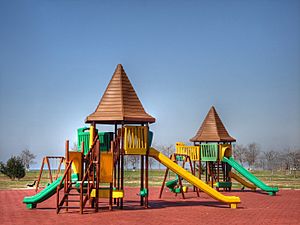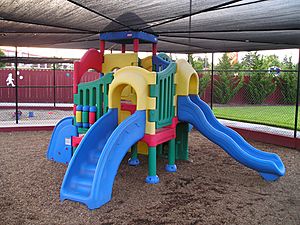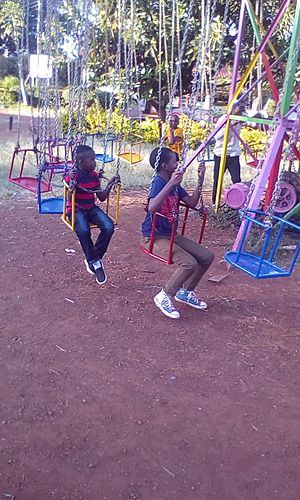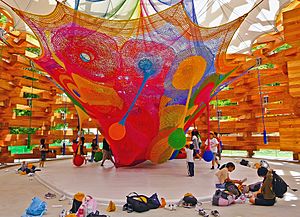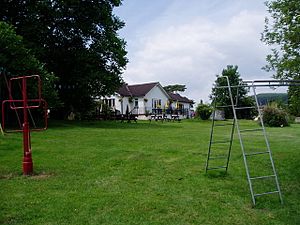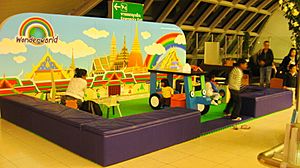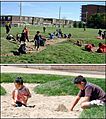Playground facts for kids
A playground is a special place where children can play. It is usually outdoors. Playgrounds are made for kids, but some are also designed for other age groups or people with disabilities.
Modern playgrounds often have fun equipment. This includes the seesaw, merry-go-round, swingset, slide, jungle gym, and sandbox. Many of these help children get stronger and more flexible. They also help kids learn to work together and express their feelings. Playgrounds often have play structures that connect different pieces of equipment.
Playgrounds sometimes have areas for sports too. You might find a basketball court or a place for skating. These areas let older kids and adults play informal games.
Public playgrounds are found in many places. These include parks, schools, and childcare centers. You can also find them at restaurants, resorts, and apartment buildings.
A special type of playground is called a playscape. These are designed to be safe places for play in a natural setting.
Contents
History of Playgrounds
For a long time, children played in their neighborhoods. They often played in the streets and lanes near their homes.
In the 1800s, thinkers like Friedrich Fröbel suggested playgrounds. He believed they could help children learn fair play and good manners. Germany built some playgrounds near schools. The first public playground opened in a park in Manchester, England in 1859.
In the early 1900s, streets became busy with cars. It became too dangerous for children to play there. People started to create safe, separate areas for kids to play.
In the United States, groups like the Outdoor Recreation League helped build playgrounds in parks.
New ideas about play also showed that playgrounds were important for learning. They could help kids pay attention in class and stay healthy. Playgrounds even made children want to come to school!
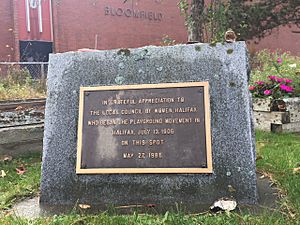
One of the first playgrounds in the United States was built in San Francisco's Golden Gate Park in 1887.
In 1906, the Playground Association of America was started. It later became the National Recreation and Park Association. Former President Theodore Roosevelt spoke about the need for playgrounds in 1907:
- City streets are not good places for children to play. They are dangerous, and many games are against the law. They are also too hot in summer. In crowded parts of the city, they can even teach bad habits. Small backyards are not enough for older children. Kids who want to play active games need special places. Since play is a basic need, every child should have playgrounds, just like they have schools. This means playgrounds must be close enough for every boy and girl to walk to, because most children cannot pay for bus fare.
After World War II, in London, a landscape architect named Marjory Allen, Lady Allen of Hurtwood had a new idea. She created "junk playgrounds" using recycled materials from bombed buildings. She wanted places for children living in new high-rise buildings. She wrote books about playgrounds and adventure playgrounds. These ideas helped playgrounds spread around the world.
Playgrounds in the Soviet Union
Playgrounds were very common in the USSR. In the 1970s and 1980s, almost every park in Soviet cities had playgrounds. The equipment was similar across the country. Most pieces were made of metal with some wooden parts. Common structures included the carousel, sphere, seesaw, and rocket.
Playground Design
Playground design depends on who will use it. For example, very young children might have separate play areas. Parks with different play areas are often used equally by boys and girls.
How Playgrounds Help Kids Grow
Experts agree that the social skills children learn on the playground can last a lifetime. Playing freely and without a plan, like on a playground, is the most helpful type of play.
Fun and challenging playground equipment keeps children happy. It also helps them learn. Equipment should be made for different age groups. For example, there's special equipment for nursery and pre-school children to learn numbers and words. Other equipment can help older kids use their imagination.
Being active helps reduce stress in children. It also makes them feel better about themselves. Playgrounds are a great way for children to exercise. They can learn physical skills like swinging, balancing, and climbing. Kids also learn to play, talk, and work with others on the playground.


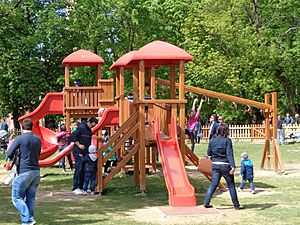
For many children, playground time is their favorite part of the day. It helps them relax from schoolwork. They know that time on the playground is their own time.
A playscape can give children a sense of ownership. Playscapes also help parents feel sure their child is safe. This feeling might not be as strong in an open field or wooded area.
Playground Safety
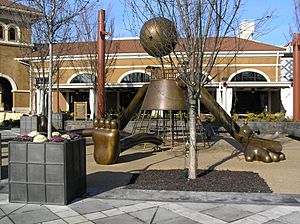
Safety on playgrounds means preventing injuries. But it's also important for children to learn how to judge risks. A place that is too safe might not let them learn this skill.
For example, old jungle gyms were often all steel bars. Newer ones might have a metal frame but use nylon ropes for climbing. Playgrounds often have soft ground materials like rubber mulch or bark chips. These help cushion falls.
Playgrounds are also made differently for different ages. Schools often have a taller, more advanced playground for older students. They might have a lower playground with less risk of falling for younger children.
Types of Playgrounds

Playgrounds can be:
- Built by groups working together to improve their neighborhood.
- Public and free, like at most elementary schools.
- Connected to a business, only for customers (like at McDonald's or IKEA).
- Businesses that charge an entrance fee (like Discovery Zone, which is now closed).
- Non-Profit places for learning and fun, like children's museums and science centers. Some charge admission, some are free.
Inclusive Playgrounds
Inclusive playgrounds are designed for all children to use. There are three main parts to making a playground truly inclusive:
- It must be easy to get around physically.
- It must be right for different ages and stages of development.
- It must offer activities that use different senses.
Some children with disabilities or different ways of developing might not use playgrounds like other kids. A playground not designed for their needs might not be fun or easy for them to use.
Many inclusive playgrounds focus on helping kids who use wheelchairs. They might have rubber paths and ramps instead of sand pits and steps. Some features are at ground level, and there are swings for wheelchairs. It's less common to see playgrounds designed for children with autism spectrum disorder. These children might find playgrounds too noisy or bright, or have trouble playing with others.
Natural Playgrounds
"Natural playgrounds" are play areas that use natural materials. These include landforms, plants, and rocks. They create fun and challenging spaces that teach children about nature while they play.
These playgrounds might have earth shapes, natural art, and local plants like trees and flowers. They can also include boulders, dirt, sand, natural fences, and water features.
Images for kids
-
Jacques-Laurent Agasse: The Playground, 1830.
-
A playground under construction in Ystad, Sweden in 2016.
-
A playground at Käpylä sports park in Pasila, Helsinki, Finland.
-
A thematic playground with an agricultural machine.
-
A wooden castle at a playground in Rakvere, Estonia.
-
A playground in Ystad, Sweden in 2019. The colorful surface is soft rubber asphalt.
See also
 In Spanish: Espacio de recreación para niños
In Spanish: Espacio de recreación para niños


